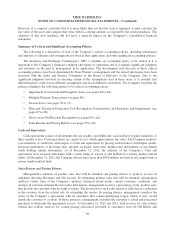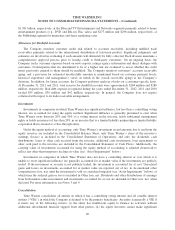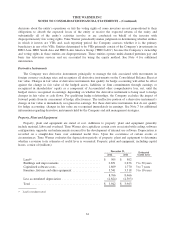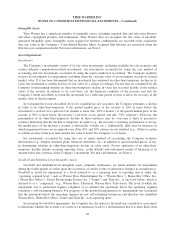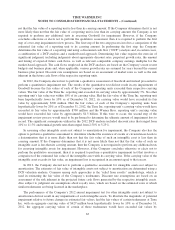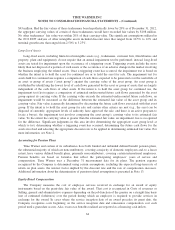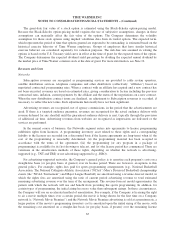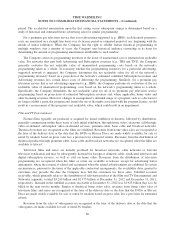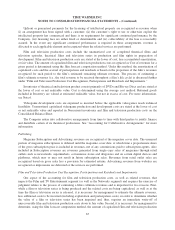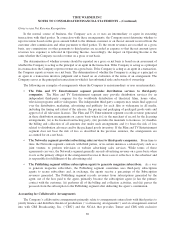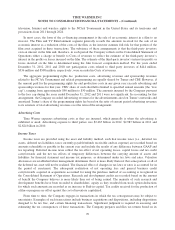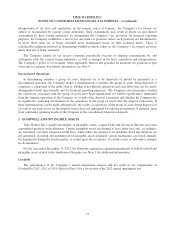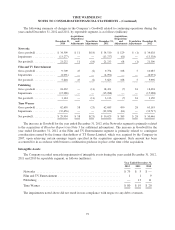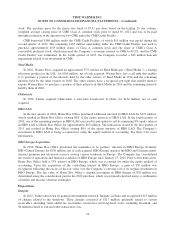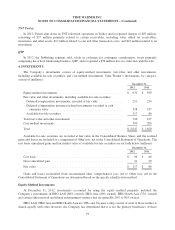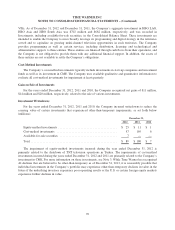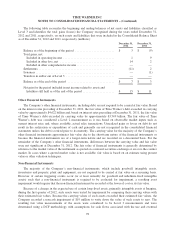Time Magazine 2012 Annual Report Download - page 84
Download and view the complete annual report
Please find page 84 of the 2012 Time Magazine annual report below. You can navigate through the pages in the report by either clicking on the pages listed below, or by using the keyword search tool below to find specific information within the annual report.TIME WARNER INC.
NOTES TO CONSOLIDATED FINANCIAL STATEMENTS – (Continued)
costs and the amount of participations and residuals to be recognized as Costs of revenues for a given film or
television series in a particular period. To the extent that the ultimate revenues are adjusted, the resulting gross
margin reported on the exploitation of that film or television series in a period is also adjusted.
Prior to the theatrical release of a film, management bases its estimates of ultimate revenues for each film on
factors such as the historical performance of similar films, the star power of the lead actors, the rating and genre
of the film, pre-release market research (including test market screenings) and the expected number of theaters in
which the film will be released. Management updates such estimates based on information available during the
film’s production and, upon release, the actual results of each film. Changes in estimates of ultimate revenues
from period to period affect the amount of production costs amortized in a given period and, therefore, could
have an impact on the segment’s financial results for that period. For example, prior to a film’s release, the
Company often will test market the film to the film’s targeted demographic. If the film is not received favorably,
the Company may (i) reduce the film’s estimated ultimate revenues, (ii) revise the film, which could cause the
production costs to increase, or (iii) perform a combination of both. Similarly, a film that generates lower-than-
expected theatrical revenues in its initial weeks of release would have its theatrical, home video and television
distribution ultimate revenues adjusted downward. A failure to adjust for a downward change in estimates of
ultimate revenues would result in the understatement of production costs amortization for the period. The
Company recorded production cost amortization of $3.755 billion, $3.658 billion and $3.088 billion in 2012,
2011 and 2010, respectively. Included in production cost amortization are film impairments primarily related to
pre-release theatrical films of $92 million, $74 million and $78 million in 2012, 2011 and 2010, respectively.
Barter Transactions
Time Warner enters into transactions that involve the exchange of advertising, in part, for other products and
services, such as a license for programming. Such transactions are recognized by the programming licensee (e.g.,
a television network) as programming inventory and deferred advertising revenue at the estimated fair value
when the product is available for telecast. Barter programming inventory is amortized in the same manner as the
non-barter component of the licensed programming, and Advertising revenue is recognized when advertising
spots are delivered. From the perspective of the programming licensor (e.g., a film studio), incremental licensing
revenue is recognized when the barter advertising spots received are either used or sold to third parties.
Multiple-Element Transactions
In the normal course of business, the Company enters into transactions, referred to as multiple-element
transactions, which involve making judgments about allocating the consideration to the various elements of the
transactions. While the more common type of multiple-element transactions encountered by the Company
involve the sale or purchase of multiple products or services (e.g., licensing multiple film titles in a single
arrangement), multiple element transactions can also involve contemporaneous purchase and sales transactions,
the settlement of an outstanding dispute contemporaneous with the purchase of a product or service, as well
as investing in an investee while at the same time entering into an operating agreement. In accounting for
multiple-element transactions, judgment must be exercised in identifying the separate elements in a bundled
transaction as well as determining the values of these elements. These judgments can impact the amount of
revenues, expenses and net income recognized over the term of the contract, as well as the period in which they
are recognized.
In determining the value of the respective elements, the Company refers to quoted market prices (where
available), independent appraisals (where available), historical transactions or comparable cash transactions and
the Company’s best estimate of selling price. Other indicators of value include the existence of price protection
in the form of “most-favored-nation” clauses or similar contractual provisions and individual elements whose
values are dependent on future performance (and based on independent factors). Further, in such transactions,
evidence of value for one element of a transaction may provide support that value was not transferred from one
element in a transaction to another element in a transaction.
68



